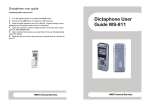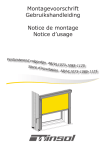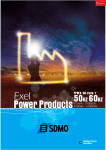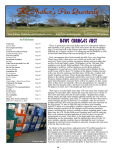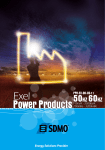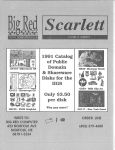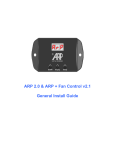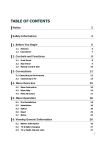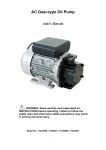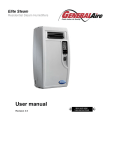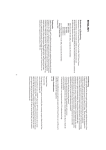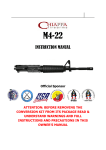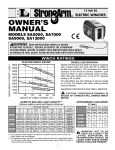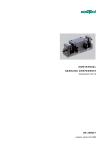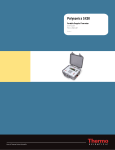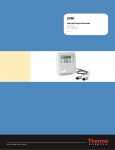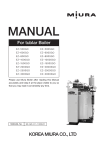Download HWB Series User Manual
Transcript
Menu INSTRUCTIONS FOR THE INSTALLATION AND USE OF THE PUMPS HWB 8040--100-110-150-200-250-300 300-400 1 Dear Customer, We would like to thank you for the trust you granted us and are sure that you made the right choice. The NERÒN pumps are hydraulic transformers with three actuated axial plungers transforming the power of the hydraulic system into hydraulic power on a separate circuit (fresh and salted water, oil, glycol etc.). The HWB (high pressure water bluster) have been developed considering the needs of the high pressure-washing field. They are equipped with specific devices that, together with the suitable washing lance, allow an easy & safe use. THE COMPLIANCE WITH THE FOLLOWING OPERATING INSTRUCTIONS WILL ALLOW YOU TO USE YOUR PUMPS ACCORDING TO THE BASIC SAFETY REQUIREMENTS AND WILL HELP TO MAINTAIN IT PERFECTLY EFFICIENT FOR LONG PERIOD. 1 GENERAL SAFETY RULES The high power of the high pressure jet can be the cause of serious hazards Keep people, animals and any brittle object far away while the pump is running. Carefully read this manual before using the pump and keep this booklet and spec. with the pump or in a accessible area. The high pressure hoses must be certified for over and above the working pressure allowing for the pump. Certified data must be printed on the hoses together with the max allowable temperature and manufacturing date. Never use a defective and/or old, damaged hoses. Always wear glasses and protective clothing when using the pump. • Strictly keep to the rules concerning the clearance of the substances coming off the surfaces hit by the highpressure jet. Do not use the pump to clean surfaces containing asbestos. • When cleaning delicate surfaces use only nozzles with a fan jet, keeping it at a minimum distance of 30”. • When using the pump make sure that it lays on a steady, solid and firm support. • Always hold the lance with both hands during washing operations. • Do not use detergents containing a high ammonia percentage. Never leave the hose (7)undern pressure. This can cause hazard to people or objects in case the gun trigger is unintentionally pulled. Never direct the jet against people, animals, brittle parts in general, on nearby or on electric device cables and plugs. Never put your hands in front of the high pressure jet. (INJURIES HAZARD) 2 WARRANTY • NERÒN warrants its product form manufacturing or material defects and for lubricated parts for two years from the date of purchase except for the high pressure seals, the wear parts or the components damaged by an improper use. The pump will have, always, to be returned to Neròn at customer’s cost and care. The warranty is void if the pump has been tampered and if the unloader or the by-pass device has, also, been tampered. • Each pump is identified with a unique number printed on the manifold; the first figure identifies the fabrication year, the second two figures the fabrication month and following the progressive serial number. • The HWB can be supplied with a rating plate, upon request. Data to be strictly respected. The pump model, and serial number must be stated when ordering spare parts. • The manufacturer declines all responsibilities for damages to the pump, to people, animals, and things due to an improper use of the pump. • NERÒN, at any time, can revise this manual and/modify its products with no notice obligation. 2 3 PUMP’S INSTALLATION AND USE • The rotation speed and consequently the performance of the NERÒN units are directly related to the oil flow of the supply circuit (P1). • Make sure that the oil flow of the hydraulic system does not exceed the values stated in this manual or on the rating plate. (min. 3,9 GPM; max 6,6 GPM). Supplying the pump with an excessive oil flow will cause an improper running, possible cavitation and internal parts breakages. • If your hydraulic system is not equipped with an oil flow device, and/or it is not possible to measure or limit the effective inlet oil flow to the pump, an oil flow limiting device has to be mounted on the inlet line (3). (see page 9) • The oil must be suitable for hydraulic systems. The oil temperature must not exceed 176°F, the oil flow must be constant and may increase of about 5% according to the oil temperature. • Maximum allowed pressure in the oil return line to the tank: 145 PSI • Inlet and outlet oil hoses dimension and port: flexible type, minimum ½” or bigger. • Inlet water hose dimension: 1”, flexible type. • Outlet water hose size: 5/16” minimum, flexible type. • Never run the pump with no water; adopt a safety control system. • Make sure the oil quantity available in the tank and the minimum water level do not create turbulence into the pump • Drain at the end of every working day the water from the suction cover • THE HYDRAULIC OIL DOES NOT NEED TO BE REPLACED BUT ONLY FILTRATED a) Installation 1. Fix the pump on a sufficient wide and solid base or fix it through the fixing holes (3 holes on one side of the block and 4 on the other side of the block) located on the pump in any desired position. Always, use vibrationdampeners. 2. Make sure that the oil/water vent plug is not covered (in order that any leakage is visible by the operator) but has an escape way; use spacers. It is also possible to install a pressure switch on the port. See here in under: 3. Install the pump in such a way that possible oil leaks from the vent valve cannot cause any damages to people, animals or objects. In case of wrong hoses connection (3) & (5) or in case of an excessive back pressure in the return line (5), the vent valve (S) will open discharging the oil. 4. Connect the water inlet hose (12) to the water inlet port (3/4” BSP M or 3/4” BSP F). The pump must always be installed with a positive suction head. Cavitation will occur if operated with a suction lift. 3 5. Connect the oil return hose (5) to the outlet port (T1) ½” BSP F, mark “OUT” on the carter; (it is necessary to use the Neròn nipple in order to avoid the oil flow obstructing, causing a pressure increase on the return line and the vent valve): max torque 40 Nm make sure the oil is discharged freely to the hydraulic tank (1) and does not create vacuum with the suction hose. 6. Connect the oil high pressure hose (3) to the port (P1) ½” BSP F (mark “IN” on the carter). During the operation in order to prevent any rotation of the nipple at P1, hold it firmly by using an hexagonal wrench of 1,06”, but it is very important not to force in order to avoid moving of the internal components. 7. Connect the water high pressure hose (7) to the port (P2). Max water temperature: 110° F with thermal valve and 165° F with the by-pass valve to water tank and viton seals. 8. Connect the by-pass valve to the water tank (only when the thermal valve is not mounted) 9. Switch on the pump. 10. Open the lance knob (9) to release the air. 11. Increase gradually the pressure by closing the lance knob. Make always sure that all connections are tight before starting the operations. Always use thread sealing. DO NEVER PAINT THE PUMP. CONNECTION SCHEMA LEGENDA: 1 Oil reservoir 2 Oil pump 3 High pressure suction oil hose 4 Oil pressure gauge 5 Oil return line to the reservoir 6 Water pressure gauge 7 High pressure hose 8 9 10 11 12 4 Washing lance and gun Pressure regulation knob High pressure nozzle (use the turbo nozzle for an accurate cleaning) Low pressure nozzle Water suction hose (net type) CONNECTION OF THE BY-PASS VALVE TO THE WATER TANK M Unloader C Nut V Water pressure regulation nut 6 Water pressure gauge 1133 Pressure gauge port P1 Oil inlet connection P2 Water outlet connection T1 Oil outlet connection to the reservoir Q2 Water inlet connection S Safety relief valve or vent valve Built-in by-pass device Thermal relief valve or water by-pass to tank (to be connected to the water tank) Oil outlet from the carter Hydraulic lubricated power system Use with fresh water, salt water, glycole, oils and chemicals fluids b) Chemical suction device (when applicable) This accessory can be used only if the pump sucks water from any reservoir with no pressure in the supply hose. In case the water supplyg line is pressurised only an external chemical injector can be mounted. Both accessories are available at Neròn’s premise.s 1. Unscrew the plug or the water vent valve (1) placed on the “suction cover”. 2. Wrap the thread port of the suction nipple (2) with teflon. 3. Insert in the back part of the nipple the ball, first, (3) and then the spring (4) using some grease to keep their positions. 4. Screw the nipple using a hexagonal wrench 0,5”. 5. Connect the coupling to the chemical reservoir by means of flexible hose with inside diameter 0,2”. 6. The quantity of chemicals sucked is adjustable, through the knob (5), from zero (with the knob completely screwed) up to the maximum value (with the knob completely unscrewed). 5 Always respect the existing laws for the type of chemical used, both for the proper use and clearance. Use only chemicals slightly alkaline (pH 9,1 solution 1%) biodegradable beyond 90% and compatible with the inner tube and cover of the hoses. 7. It is possible to mount a chemical injector M22 swivel end, at the water output (depression suction), if the chemical is too aggressive to avoid to damage the pump. 8. If the chemical injector is not installed on the suction cover, the water drain valve needs to be mounted (see Neròn), in order to drain the water. This will avoid water freezing mainly in winter time. c) Pressure gauge, filter, hose tail mounting 1. Take off the protection plastic plug from the port by a screwdriver (1). 2. Wrap the nipple thread (1) with some teflon tape. 3. Screw on the filter with the arrow in the inlet direction (standard neròn ¾” FF), or a different one, but suitable for the application, with 200 to 360 micron filtration strainer; always wrap the nipple thread (1) with teflon every time the filter is replaced, in order to avoid air suction. • The capacity of each filter must be at least 3 times the rated pump volume • Filter port diameters should not be smaller than the pump inlet ports. 4. Screw in the hose tail directly on the filter port. 5. Take off the plastic cup from the port ¼” BSP (5) with a screwdriver, wrap the thread of the pressure gauge (4) with teflon tape and screw it with a fork wrench 0,5”. Do not tighten the pressure gauge seizing the dial with hands in order not to break it. NOTE: Mount the pressure gauge both on the inlet and outlet lines. The position of the suction nipple can be changed (pos. A-B-C-D) by removing the four fixing screws of the fixing hole of the cover. USE 1. Make sure that the end of the connection hose to the reservoir is completely plunged in the liquid to suck and it cannot suck air. 2. Release the air from the low pressure nozzle on the lance, while the pump is running. 3. Open the suction nipple knob, keeping the gun trigger disengaged and, wait a few minutes making sure that possible air bubbles have been released. 4. Adjust the quantity of the chemical detergent sucked through the knob (5) and spray with the lance either in low or high pressure, as you wish. In order to stop the action of the chemical detergent close the knob (5) turning it clockwise until the end of its run. A SUITABLE SUCTION FILTER (1) HAS TO BE MOUNTED AS CLOSE AS POSSIBLE TO THE PUMP, ALLOWING EASY INSPECTION & MAINTENANCE 6 5. After using chemicals or other liquids always rinse the pump, making it run for few minutes with fresh water. 6. If, during operation, the pump becomes noisier and the jet inconsistent, it means that the pump is sucking air. Open, immediately, the low pressure nozzle and release the air. d) Flow and pressure limiting valve block In case you cannot adjust the oil inlet flow to the pump maximum allowed flow or, the oil flow is not constant, it is necessary to mount a valve in order to limit and control the flow (RF). In case you cannot adjust the oil flow and the oil pressure, in order to protect the pump, you need to mount a flow and pressure valve limiting device (RFP). Each valve can handle inlet flow up to 20 GPM; it is calibrated for 6,6 GPM; the oil over flow is discharged to the oil reservoir. When considering placing an order, please give Neròn the details of the flow and the pressure available in your hydraulic system in order to supply you with the valve block, tested with the correct features. For mounting operation follow the schemas: P C ENTRATA OIL OLIO INLET B A RF C Pompa Neròn A OILUSCITA OLIO T OUTLET B Neròn pump C B A RFP T N:B.: The assembly and testing operation of the block has to be done at Neròn’s premises, in order to avoid the wrong connection and functioning. e) Oil side connection CORRECT OPERATION: HOLD WITH A KEY THE OIL INLET OR OUTLET NIPPLE ON THE PUMP AND WITH THE OTHER KEY UNSCREW O SCREW IN THE CONNECTOR 7 WRONG OPERATION: UNSCREW OR SCREW IN WITH A KEY THE OIL INLET OR OUTLET NIPPLE 4 FIRST STARTING Make sure the oil inlet supply flow does not exceed the maximum allowable data and keep it constant. (see page 13) 1. Reduce, to the minimum allowed, the flow of the hydraulic system adjusting, according to the situation, the rotation speed of the engine that runs the pump (2) or the flow limiting device of the system or the one of the pump (2). 2. Turn the knob (9) of the lance until the low pressure jet (11) is completely open. 3. Keep the gun trigger engaged. 4. Once the air released, close the lance knob and increase, if necessary, the oil flow until the pump reaches the desired pressure. 5. Close gradually the lance knob making sure that the pressure gauge needle does not exceed the working pressure (see page 11 Test & calibration data). Should the needle go beyond the working pressure, it means that the oil supply to the pump, is still too high. It must be reduced. On the contrary, gradually, increase the oil flow till the pressure gauge will state the correct working pressure, with the knob (9) completely close. In the above condition the hydraulic system is perfectly set. Should the pressure in the hydraulic system be too low, and cannot be increased, change the high pressure spray nozzle for one of smaller hole. This is in order to avoid that the safety valve in the hydraulic system remains open. With the gun open, adjust the unloader pressure of about 217 PSI higher in respect to the working pressure. This is in order to avoid a recycle in the pump manifold or any pressure jerks. When the gun is closed, the water pressure has to be at least 145 PSI lower in respect to the safety valve of the hydraulic system. The new set-up must be made only by authorised personnel. 5 START-UP 1. Turn the lance (9) knob until the low-pressure jet is completely open (11). 2. Keep the gun trigger engaged. 3. Supply the pump with oil under pressure and let it run until the air in the hoses is completely released and the water flow that comes out from the low pressure nozzle (11) has become consistent and continuous. 4. Gradually close the lance knob until the water pressure gauge needle (6) shows the working pressure. With the knob (9) completely closed the pressure gauge needle should not exceed the maximum pressure stated in the rating plate. 5. Open and close the trigger gun few times, checking that the unloader works properly (M). By releasing the gun trigger, the pump must stop and restart as soon as the trigger is engaged again and/or activate the recycling, in the by-pass version. By releasing the gun trigger, the pressure at the pressure gauge must go below 145 PSI and go back to the set up data as soon as the trigger is engaged again. In case of improper running or bad functioning, open the low pressure nozzle of the lance (9) and stop the operations. Verify that: the pump is supplied with the requested oil flow the suction water filter and the nozzle are dirty or obstructed 8 the unloader is adjusted too high or too low the pressure on the return line doe not exceed 145 PSI the threads are tight and there is no air infiltration. 6 FROST PRECAUTIONS When there is risk of freezing run the pump for a minute with no pressure, keeping the gun trigger disengaged, so that possible ice melts. Flush the system with solution of anti-freeze or oily solution until the anti-freeze works throughout the system. Do not operate the pump at high pressure with exhausted oil. Follow the basic rules for the hydraulic circuits. Do not operate the pump at high pressure if the hoses are frosted. Before operating the system thaw-out the parts. At the end of the operation close or disconnect the water inlet line and release the pressure keeping the lance knob open. Drain all suction and delivery lines, including filter. If the pump is frozen or appears frozen, do not operate it until the entire system has been thawed. In case the pump is used in cold condition it is necessary to use the water vent valve, available at Neròn’s, to drain the water in the cover plate at the end of every working day. 7 TEST AND CALIBRATION DATA Hereinafter, test and calibration data, standard manufacturer test for 15-20 minutes at Neròn premises: MODEL OIL INLET FLOW OIL INLET PRESSURE OUTLET WATER PRESSURE OUTLET WATER FLOW UNLOADER CALIBRATION NOZZLE (HOLE ø) HWB 8040 6 GPM 2820 PSI 1010 PSI 10 GPM 3800-3850 PSI HWB 100 4,8 GPM 2600 PSI 1300 PSI 5,7 GPM 1900-2050 PSI HWB 110 6,6 GPM 3625 PSI 1595 PSI 9,8 GPM 2465-2620 PSI HWB 150 5,8 GPM 3625 PSI 1885 PSI 6,8 GPM 2465-2610 PSI HWB 200 6 GPM 2465 PSI 1815 PSI 5,5 GPM 2175-2320 PSI HWB 250 6 GPM 2755 PSI 3260 PSI 4,2 GPM 3770-3915 PSI HWB 300 5,8 GPM 1740 PSI 2465 PSI 2,6 GPM 3480-3625 PSI HWB 400 5,8 GPM 1740 PSI 2320 PSI 2,3 GPM 3480-3625 PSI 50 ¼”meg (4,2 mm) 10 ¼”meg (1,9 mm) 30 ¼”meg (3,3 mm) 10 ¼”meg (1,9 mm) 08 ¼”meg (1,7 mm) 04 ¼”meg (1,2 mm) 03 ¼”meg (1,1 mm) 02 ¼”meg (1 mm) In order to set up your pump properly during testing at Neròn workshop, please supply to the manufacturer all technical details of your hydraulic system. 8 END OF THE OPERATION 1. Close the gun and turn the knob to let water run to the low pressure nozzle (8) of the lance. 2. Stop the oil supply line to the pump. 3. Unload the pressure from the hose (7) by engaging the gun trigger. 4. Drain the water from the suction cover. Before closing the oil supply line to the pump always open the low pressure nozzle of the lance. In order to avoid serious damages to the pump do never stop the oil supply line while the pump is running at a pressure above 725 psi.. 9 9 MAINTENANCE INSTRUCTIONS The HWB does not require any regular maintenance. If a leak develops maintenance is required. The filter, in any case, must be kept clean in order to avoid bad supply problems and cavitation. Clean the filter daily, more often in poor water conditions, (water heavy of sand or iron) to prevent premature pump wear and damage, in particular the breakage of the thermal valve, when mounted. 10 PUMP STOP FOR LONG PERIOD If you foresee a long inactivity period it is recommended to drain the water from all suction lines. Before starting the pump, again, check for correct hydraulic oil level. Before operating the pump in high pressure flush with water at low pressure. PUMPS PERFORMANCE HWB 8040 6,6 HWB 100 5,2 HWB 110 6,6 HWB 150 6,6 HWB 200 6,6 HWB 250 6,6 HWB 300 6,6 HWB 400 25 Flow ratio factor Q2/Q1 1,6 1,3 1,5 1,3 1 0,67 0,5 0,4 Max discharge flow at P2 (GPM) 11 6 10 8,6 6,6 4,4 3,3 10 MODEL Max inlet oil capacity at P1 (GPM) Multiply the available hydraulic oil volume by the flow ratio factor to calculate your discharge flow(ie 6,6x1,3) MODEL Max inlet oil pressure (PSI) Pressure ratio factor P2/P1 Max discharge pressure (PSI) HWB 8040 3000 HWB 100 2680 HWB 110 4050 HWB 150 3625 HWB 200 3625 HWB 250 2755 HWB 300 2030 HWB 400 180 0,8 0,55 0,45 0,6 0,8 1,2 1,75 1,9 1160 1450 1740 2175 2900 3306 3553 340 Multiply the available hydraulic pressure by the pressure ratio factor to calculate your discharge pressure:ie 3625x0,6) 11 TROUBLES SHOOTING PROBLEM POSSIBLE CAUSE The required pressure is reached before the The nozzle is dirty or too small lance knob (9) is completely closed. Excessive oil quantity to the pump The pump is supplied with too much oil The pressure is not stable and the pump stops The nozzle is dirty or too small during working operation Unloader (M) set at a too low value REMEDY Clean or replace the nozzle Reduce the oil flow at P1 Reduce the oil flow at P1 Clean or replace the nozzle Reset the unloader at the right value (*) The oil inlet flow is insufficient or Screw in the unloader (*), reduce the oil inlet flow of the primary circuit The pump does not reach the working excessive pressure as per the calibration data Release the air for the lines and verify The pump is sucking air the hydraulic line Oil is leaking from the valve (S) Excessive pressure in the carter Replace the return line (advised ½ or ¾) Oil return line (5) crushed or obstructed Excessive back pressure in the return Verify and calibrate the hydraulic line (5) system Stop immediately the operation Oil or water is leaking from the vent valve on Lack of water or dirt might have Replace the seals and check the pistons the pump housing damaged the seals 10 Water is leaking from the manifold and from Worn O-R between manifold and Check and replace the O-R (*) the pump housing housing worn (HWB) The pump sucks air: - from the suction line or from the couplings The pump is noisy and the pressure at the - cavitation or vacuum in the main pressure gauges waves hydraulic system Replace the water suction hose and/or tighten the coupling or replace the seals Release the air from the suction line and verify the main hydraulic system The pump cavitates: Replace the hose with one having - the suction hose (12) is too small, adequate section and quality (see technical data) crashed or obstructed clean and replace the filter cartridge - the water suction filter is dirty Inlet or outlet valves worn Check and replace the valves (*) High pressure seals worn Check and replace the water seals (*) The pump does not stop by releasing the gun Unloader valve incorrectly set trigger defective The pump does not work in by-pass when By-pass incorrectly set or defective releasing the gun trigger (*) or Adjust and/or unloader (*) repair the pressure Adjust and/or valve(*) repair the by-pass Operation to be carried out only by authorised personnel NOTE: In case of breaks, from oil side, it means the pump runs with no water or the oil supply flow and/or the pressure are not constant and exceed the max allowed values. Record the data with a digital instrument. CONFORMITY REPORT Product: High pressure pump hydraulically driven HWB 8040 BY-PASS HWB 100 BY-PASS HWB 110 BY-PASS HWB 150 BY-PASS HWB 200 BY-PASS HWB 250 BY-PASS HWB 300 BY-PASS HWB 400 BY-PASS The construction of the machine is according to the following spec.: 89/392/EWG SERIAL N.: SIGNATURE: Treviglio, 01.01.2000 NERÒN Pumps S.r.l. Plant & Offices: 24020 Ranica (BG) ITALY Via Locatelli, 13 Tel. +39-035-514679 Fax +39-035-0662453 e-mail: [email protected] web site: www.neron.it 11 NOTES OIL SIDE 1 Hose diameter on the return line 2 Hose length on the return line 3 Oil inlet flow 4 Oil inlet pressure: a) specify opening picks b) specify closing picks 5 Back pressure at the pump outlet 6 When closing the gun: a) specify flow picks b) specify pressure picks WATER SIDE 1 Suction hose internal diameter 2 Suction hose length 3 Filter type: a) filtration capacity (micron) 4 Nozzle hole diameter (mm) 5 Specify water inlet: a) out take b) suction 6 Water type: a) fresh b) salt c) with chemicals (specify type) BLANK SPACE FOR NOTES: 12 SHORT INSTRUCTION A Mount the pressure gauge (M) with teflon tape and install suction water filter (F) Connect the oil hoses of the hydraulic circuit: (make sure the oil is type 46, with suction filter, NAS 7 recommended) properly cooled and the hoses are not creating vacuum in the oil tank and the system is set up for the pumps’ application B P1 = Oil in pressure: ½” BSP F or NPT F Max oil temperature: 176° F Minimum oil flow: 3,9 GPM (WITH FLOW LIMITING VALVE MAX 21GPM) T1 = Oil return to the reservoir: ½” BSP F M Max flow: 6,6 GPM Max back pressure: 70 PSI F P2 T2 TI P1 C D Connect the water hoses: T2 = Water suction; avoid air suction in the hoses in order to avoid cavitation ¾” BSP M-3/4” BSPF Max prevalence 5 mt P2 = Outlet water pressure: connect to the washing lance M22x1,5 Open the lance knob (R) and release the air in the hoses to allow water suction at T2. R Feed the pump with oil, keeping the gun open. When the water flow is constant close the lance knob (R) and the pressure at P2 will increase. E By closing the gun, the outlet water flow is stopped: the water recycles in the manifold (with thermal valve) or returns to the water tank (with by-pass valve) The value stated on the pressure gauge must be higher of about 10%, with respect to the normal value obtained during washing operations. 13 SPARE PARTS LIST item code 1 2 03800210 03500090 03500171 93700030 93700035 02100340 03300180 02000160 02000170 02000190 02000200 02100350 01900100 03700060 02100070 04100020 03800140 01900180 01100140 03800150 02000060 93700090 02100290 00200070 02100460 02400140 01700020 01700040 93300020 02100470 00200080 02400130 02100480 02200060 02100490 03700100 02000210 02000230 92200070 02100500 05700012 05700021 05700022 03800250 05200010 03300240 05200120 94900050 94900060 00500130 02800080 02800050 02800060 02800190 03400070 03400060 03400050 03400130 03400160 00500120 00500110 00500100 00500090 00500140 3 4 5 6 7 8 9 10 11 12 13 14 15 16 17 18 19 20 21 22 23 24 25 26 27 28 29 30 31 32 33 34 35 36 37 description Screw TCE 5931-912 8.8 A2 12x055 (torque 5/6 kg) Brass head Anodized alluminium manifold Outlet valve (HWB 200-250-300) (torque 4 kg) Outlet valve (HWB 150) (torque 4 kg) O-R 2050 - 70°Sh Outlet valve plug (torque 4/5 kg) Outlet nipple M22 x M22x1.5 (torque 4/5 kg) Outlet nipple M22 x 3/8" F NPT (torque 4/5 kg) Outlet nipple M22 x 3/8" F BSP (torque 4/5 kg) Outlet nipple M22 x 1/2" F BSP (torque 4/5 kg) O-R 15,6x1,78 - 90°Sh Back relief valve spring Back relief hexagonal valve O-R 6x3 - 90°Sh Hexagonal nut M16 Screw STEI M16 x 40 By pass regulation spring Spring spacer Ø 13 Screw 906 8x1x8 conical Spring nipple (torque 4/5 kg) Inlet valve (torque 1,5/2 kg) O-R 18x2 - 90°Sh Back ring for O-R 7 x 2 O-R 7x2 - 70°Sh By pass piston female Pressure rear connection gauge 0-400 bar / 5700 psi (torque 2,5/3 kg) Pressure radial gauge 0-400 bar / 5700 psi (torque 2,5/3 kg) Plug with washer (torque 2,5/3 kg) O-R 2015 3,69x1,78 - 70°Sh Back ring for O-R 2015 By pass piston male with spherical head O-R 2062 15,6x1,78 - 70°Sh By pass shutter O-R 19x2 - 70°Sh Brass thermal relief valve M22x1,5 Brass water by-pass to tank dia 20 Port 3/8" BSP F Plastic elbow 90° dia 15 back to tank O-R 3300 75,87x2,62 - 70°Sh Anodized manifold cover plate 3/4"BSP M Brass suction cover 3/4" NPT F Brass suction cover 3/4" BSP F Screw TCE 5931-912 8.8 A2 5 x 025 (torque 2/3 kg) Chemical suction injector (ON REQUEST) Plug M12x1 (+ O-R 4x3 70° Sh - 02100050) (torque 2,5/3 kg) Water draining valve Neròn filter 3/4"FF 80m & hose barb 3/4"M Neròn 1 filter 3/4"MM 80m + sockets 3/4"FF & hose barb 3/4"M (on req Washer for high pressure seal Ø 25 (for HWB 150) Washer for high pressure seal Ø 21 (for HWB 200) Washer for high pressure seal Ø 18 (for HWB 250) Washer for high pressure seal Ø 15 (for HWB 300) Washer for high pressure seal Ø 14 (HWB 400) High pressure seals Ø 32x25.1x2 (for HWB 150) High pressure seals Ø 21 (for HWB 200) High pressure seals Ø 18 (for HWB 250) High pressure seals Ø 15 (for HWB 300) High pressure seals Ø 14 (HWB 400) Back ring Ø 32x25.1x2 (for HWB 150) Back ring Ø 28x21x2 (for HWB 200) Back ring Ø 26x18x2 (for HWB 250) Back ring Ø 25x15x2 (for HWB 300) Back ring Ø 25x13,5x2 (HWB 400) 14 quantity 4 1 3 7 3 1 1 1 1 1 1 1 1 2 4 1 3 3 1 1 1 1 1 2 1 1 1 1 1 1 1 4 1 1 3 6 3 item code 38 39 02100390 00600260 00600270 00600200 00600210 00600340 02800120 02800110 02800090 02800100 02800190 02100520 92400130 92400140 92400110 92400120 02400380 02100530 03600020 03600010 00910112 00900210 02100600 03000080 01900120 03300140 02400500 03800130 02100540 02000090 02000095 02000120 03600050 02000150 02000130 03300200 01900140 02900070 02100140 02700010 02700020 02700030 02600030 85400190 02600010 92300020 02600020 00200050 02100330 01900040 01000042 01000030 01200030 02100420 03900010 85400080 03200010 02800020 02800160 03800400 40 41 42 43 44 45 46 47 48 49 50 48-49-50 51 52 53 54 55 56 57 58 59 60 61 62-63 64 65-66 67 68 69 70 71 72 73 74 75-76-77 78 79 80 81 82 83 10000000 10000001 10000002 10000003 10000023 description O-R 32x1,5 - 75°Sh Brass water bushing Ø 25 (for HWB 150) Brass water bushing Ø 21 (for HWB 200) Brass water bushing Ø 18 (for HWB 250) Brass water bushing Ø 15 (for HWB 300) Boccola tenuta acqua Ø 13,7 ottone (HWB 400) Stainless steel washer Ø38 / Ø25.5 (for HWB 150) Stainless steel washer Ø38 / Ø21.5 (for HWB 200) Stainless steel washer Ø38 / Ø18.5 (for HWB 250) Stainless steel washer Ø38 / Ø15.5 (for HWB 300) Rondella Ø 14 inox (HWB 400) O-R 2137 - 70°Sh Complete piston Ø 25 (for HWB 150) Complete piston Ø 21 (for HWB 200) Complete piston Ø 18 (for HWB 250) Complete piston Ø 15 (for HWB 300) Complete piston Ø 13,5 (HWB 400) O-R 90x2 - 70° Sh Turcon-Glyde Ø 25 Turcon-Glyde Ø 12 Anodized aluminium body three-four fixing holes Brass body with three-four fixing holes O-R 5x3 - 90Sh Ball Ø 7 Valve spring Valve plug Pressure switch device (upon request) Screw TCE 5931-912 8.8 A2 8 x 065 (torque 3/3,5 kg) O-R 2068 7,17x1,78 90 sh Oil inlet nipple 1/2" BSP Oil inlet nipple 1/2" BSP F (only for brass bottom) Oil inlet nipple 1/2" NPT F Gasket 1/2" BSP Oil outlet nipple 1/2" BSP Oil outlet nipple 1/2" NPT Ventil valve plug Ventil valve spring Ventil valve seat O-R 10 x 1,3 - 90° Sh Shim 68x55x0,1 (use as needed) Shim 68x55x0,2 (use as needed) Shim 68x55x0,3 (use as needed) Flat bearing AS 5070 Oil distribution KIT Niddle bearing Wobble plate Bearing th. 4mm Back ring 25x19,3x1,5 O-R 19 x 3 - 90° Sh Half ball spring Aluminium anodized bottom Culatta ottone Oil distributor O-R 87 x 2 - 70° Sh Swaying disc Piston retainer KIT Cylindrical pin Ø 4 Washer C98 for screw Ø 8 Washer for screw M12 Nozzle (HWB 250-HWB 300) Fixing holes Aluminium revetted data plate (HWB 150) Aluminium revetted data plate (HWB 200) Aluminium revetted data plate (HWB 250) Aluminium revetted data plate (HWB 300) Aluminium revetted data plate (HWB 400) 15 quantity 3 3 3 3 3 1 6 3 1 1 2 1 1 1 4 1 1 1 1 1 1 1 1 3 1 2 1 1 1 1 1 1 1 1 1 1 1 4 4 1 1 16
















